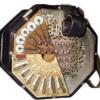Search the Community
Showing results for tags 'pads'.
-
When servicing and repairing concertina, you occasionally come across ideas from previous repairers, some are filed away for future reference, others make one want to wince. To day I have been looking at the action of a George Case baritone. Rare and beautiful until you try to play it. The problem statement was that the keys feel loose and sometimes jam. A quick examination showed a key travel of around 4.8mm, some are worse and the guide peg under the keys were hovering over the mouths of the peg holes. Clearly the keys were set far too high. Other observations show a set of brand-new pads, a total re-bushing of the keys and all new dampers. Also, the instrument has been fully re-sprung. The workmanship is neat and tidy, someone has put a lot of effort into this action, but a lot of it was wasted. The key’s vertical travel expected is usually 3.2mm (1/8 ins), yet there was a consistent ‘error’, not just on a couple of keys but across both sides. Needless to say it was a result of the last service work. The pads fitted were made with very thin felt, with the result of consistently lifting the key heights and thus the guide pegs out of their holes. This could have been OK if the action arms had been bent down to adjust the heights of the keys. Thankfully the repairer did not do that, as the brass arms on a 160yr old instrument can be very brittle and casualties can easily result. In this case the brass is so delicate and soft. I thought I had done damage when making a very minor adjustment, thankfully not. A major mistake the repairer made was to not match pad thickness to key travel and the action’s design height. By selecting appropriate pad thicknesses, you can make life so much easier and reduce risk of lever arm fracture. The next wincing point was the removal of the pads for replacement. The leather beads (AKA spuds) on the end of the arm had been bonded in place on the arm (no real problem with that), but then the pad was glued to the bead with some form of rubber glue. This glue was starting to deteriorate and was stringy and tacky, like blobs of under chewed brown chewing gum. The pads were ‘floating about’ and I had to peel the substance off each arm end fingernail full by fingernail full. I guess I am pleading here for the avoidance of ‘petroleum’ based adhesives, like rubber cement, Evode, Bostick etc, etc. Please use a traditional adhesive or a white PVA. Thankfully I was able to pick the old glue off without bending the levers. The bottom line? Choose the right thickness of pad and then set the key heights remembering the target overall travel of 3.2mm. Then use the appropriate glues. Pads should last 20 yrs plus, as must the glue.
- 5 replies
-
- 5
-

-
- action setting
- pads
-
(and 1 more)
Tagged with:
-
Hi, anyone in the UK knows any good leather supplier or website where I can find the right leather for concertina valves? I bought a sheep hide from ebay to cut and replace the valves myself, but they curl up too easily. I trimmed them to the same size and chose the same thickness as the original ones, but they tend to curl rapidly just with gravity. I’m guessing it’s a matter of stiffness and flexibility? It’s the first time I’m cutting them myself, if anyone has found the right leather I’d appreciate a bit of help. Thanks.
-
Initial inspection of the Lachenal TT shows it to be in relatively good cosmetic condition. The keys and bushings needed cleaning and polishing only. The 7-fold bellows appear to be in like-new condition but stiff from lack of use. I replaced the valves for obvious reasons. The instrument had been stored on it's end. I've yet to replace the pads except for a couple that needed immediate attention. It had been re-tuned to A440. I made a new case for it as it arrived without one. It is the one on the right, next to my Lachenal New Model extended treble.
-
Crabb Concertina- for details click here
-
- New bellows
- valves
-
(and 2 more)
Tagged with:



